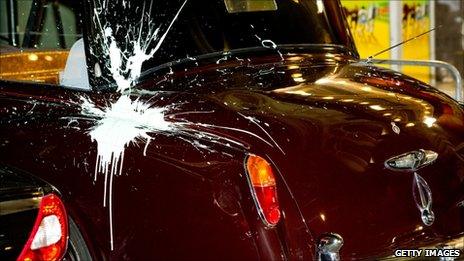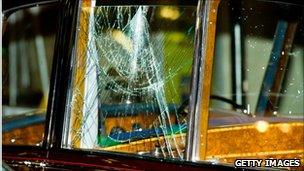Could Charles and Camilla have been better protected?
- Published

A small group of protesters surrounded the car and threw paint at it
The image of the Duchess of Cornwall open-mouthed in shock as her car came under attack has already come to define the tuition fees protests.
It has also raised questions about the way the Royal Family are protected and whether the right route and right car were chosen.
Prince Charles and the Duchess of Cornwall were travelling to the Royal Variety Performance at the London Palladium on Thursday evening.
On Regent Street, their car was surrounded by as many as 20 demonstrators, chanting "Off with their heads" and "Tory scum". One of the windows was smashed and paint was thrown at the vehicle.
Former royal protection officer Ken Wharfe told the BBC the royals' "shiny brown limousine" was "a challenge" the crowd couldn't resist - and once it became a target, escape was very difficult.
"From my own experience, it is a vehicle that is very difficult to manoeuvre in any area, let alone a congested street at Christmas time," he said.
"I do think this was the classic example where the Prince of Wales should have been using his armoured Bentley - it's far less conspicuous.
"It was the sheer conspicuousness of this vehicle in a busy street in the wake of this demonstration that caused the problem."
Armed outriders
The job of keeping the royals safe falls to the Royalty Protection Specialist Operations unit of the Metropolitan Police - or SO14.
This elite group is divided into three sections. The first, Personal and Close Protection, effectively provides bodyguards for the Royal Family, both at home and on overseas trips.
The second, Residential Protection, guards the royal homes in London, Windsor and Scotland.
The third - and the one most in the spotlight now - is the Special Escort Group, which provides protection to the Royal Family when they are on the move.
Key to the SEG are armed motorcyclists who travel as outriders for the VIP convoy and look ahead for trouble - several were on hand on Thursday night.
Other SEG officers were travelling in a Jaguar back-up vehicle behind the royals' car.
All royal protection officers are highly trained and experienced - which perhaps only adds to the questions being asked about what went wrong in this case.
Security analyst and former police officer Charles Shoebridge said: "This is a very serious incident. It ranks amongst the most serious security breaches of the past decade.

The Rolls Royce's windows are toughened but the car itself isn't armoured
"Some of the demonstrators yesterday were carrying petrol, specifically to use in arson attacks. If the can of paint had been a can of petrol, it would have been very different."
Alternative routes
The first decision in planning any potential royal engagement is to consider the risks involved and whether they outweigh the benefits of going ahead.
In this case, the decision was made that they didn't - in part no doubt because of the importance of the event; the Variety Performance is Royal for a reason.
So assuming the journey had to be made, how could the threats be minimised?
The vehicle used by Prince Charles and his wife was a Rolls Royce Phantom VI - a state limousine designed to show off the royal family to the public at glitzy events like the Royal Variety Performance.
Its windows are toughened but it is by no means built to cope in a riot, so an armoured alternative, as suggested by Ken Wharfe, might have been better.
Then there was the route taken to the venue.
Met Police Commissioner Sir Paul Stephenson said it had been "recced" - checked out - by SEG officers just a few minutes before the royal car arrived and it was clear.
But he said there was then "an unpredictable movement of some numbers of demonstrators" that led to the problems.
Former head of Royal Protection Dai Davies told the BBC that, although it was true to say that protection was never "an exact science", there were questions to be asked about communication and preparation.
"One of the principles of protection is to have alternative routes - I would expect there to be at least three different routes," he said.
"I'm surprised, and clearly the commissioner is embarrassed and surprised, why there wasn't better coordination... between those in charge of protection and those marshalling and dealing with the riots we saw."
Former assistant Met commissioner Brian Paddick criticised the apparent failure of the SEG outriders to see the trouble coming.

But he pointed out that the attack occurred near Regent Street - a major thoroughfare - and using much narrower side roads instead could actually have been more, not less, dangerous.
Big bill
Royal Protection officers are armed for a reason and can open fire if the situation demands it.
Sir Paul refused to be drawn on whether they were authorised to shoot at the protesters, but insisted officers had shown "enormous restraint and great judgement" in deciding how to react last night.
However, some previous royal security incidents have involved very serious violence.
In 1974, Princess Anne was the target of an attempted kidnap by a mentally ill man when she was driving along The Mall.
Four people, including her bodyguard, Jim Beaton, were shot.
Despite rare cases like these the Royal Family continue to pride themselves on getting out and about being visible to the public.
But allowing them to do that takes a lot of expensive work by police.
It costs the Met about £50m a year to protect 22 members of the Royal Family but the Met commissioner is currently involved in a dispute with the government over what he says is big shortfall in the amount that it is paying his force to carry out those duties.
- Published10 December 2010
- Published18 July 2010